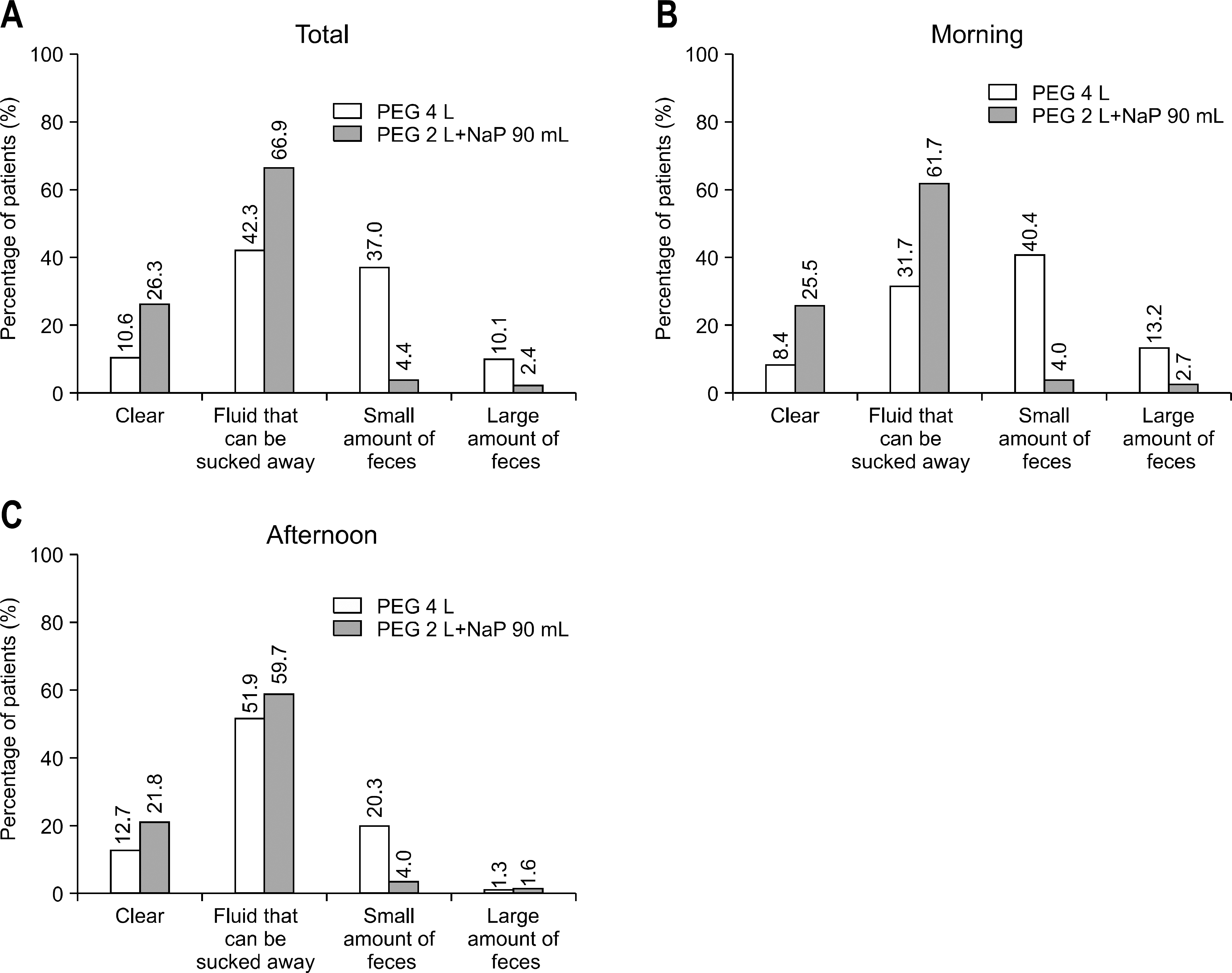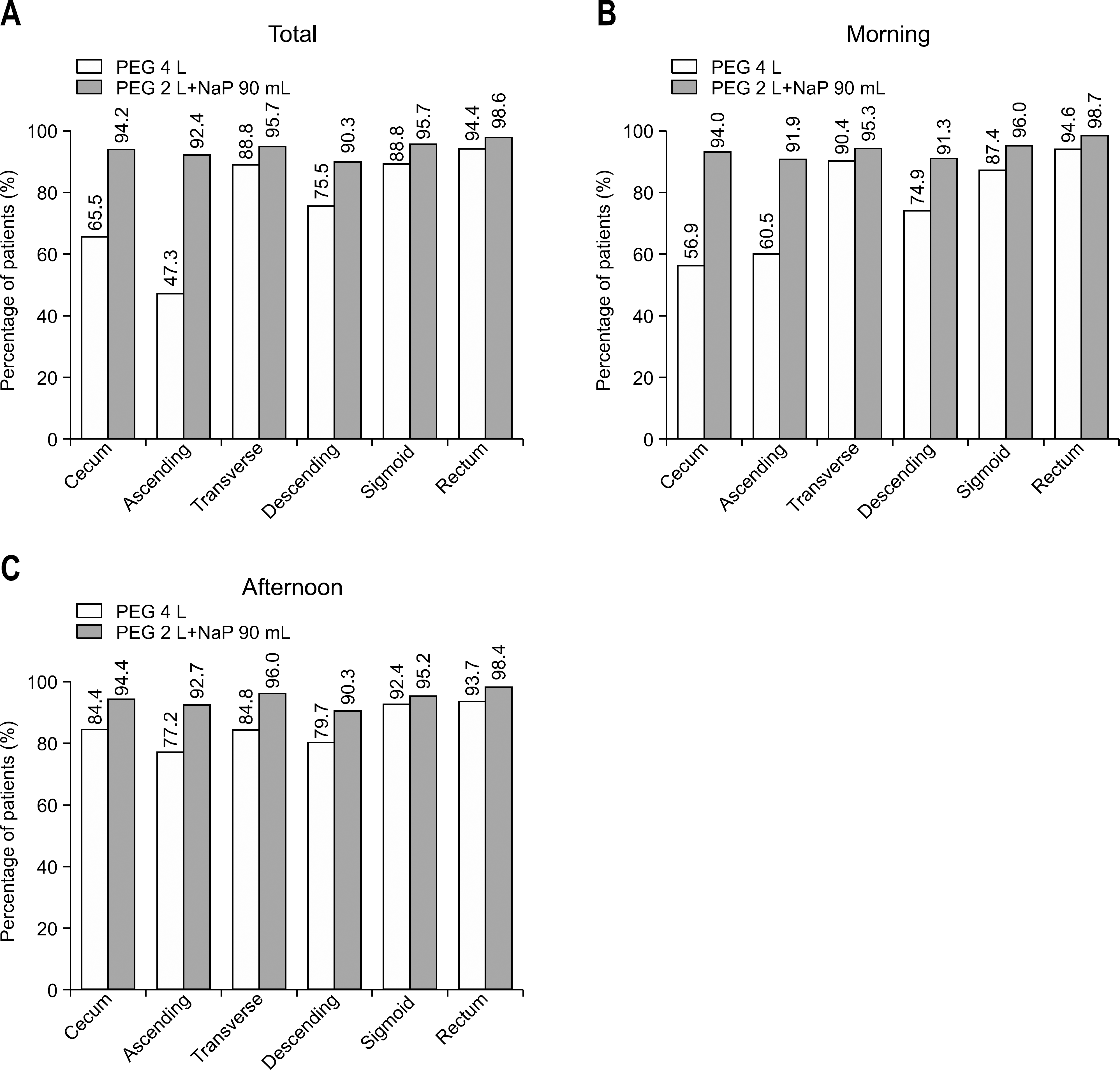Abstract
Background/Aims
Effective bowel preparation is essential for accurate diagnosis of colon disease. We investigated efficacy and safety of 2 L polyethylene glycol (PEG) solution with 90 mL sodium phosphate (NaP) solution compared with 4 L PEG method.
Methods
Between August 2009 and April 2010, 526 patients were enrolled who visited Seoul National University Bundang Hospital for colonoscopy. We allocated 249 patients to PEG 4 L group and 277 patients to PEG 2 L with NaP 90 mL group. Detailed questionnaires were performed to investigate compliance, satisfaction and preference of each method. Bowel preparation quality and segmental quality were evaluated. Success was defined as cecal intubation time less than 20 minutes without any help of supervisors.
Results
Both groups revealed almost the same baseline characteristics except the experience of operation. PEG 4 L group's compliance was lower than PEG 2 L with NaP 90 mL group. Success rate and cecal intubation time was not different between two groups. Overall bowel preparation quality of PEG 2 L with NaP 90 mL group was better than PEG 4 L group. Segmental bowel preparation quality of PEG 2 L with NaP 90 mL group was also better than PEG 4 L group in all segments, especially right side colon. Occurrence of hy-perphosphatemia was higher in PEG 2 L with NaP 90 mL group than PEG 4 L group. However, significant adverse event was not reported.
Go to : 
REFERENCES
1. Tan JJ, Tjandra JJ. Which is the optimal bowel preparation for colonoscopy - a metaanalysis. Colorectal Dis. 2006; 8:247–258.

2. DiPalma JA, Brady CE 3rd. Colon cleansing for diagnostic and surgical procedures: polyethylene glycol-electrolyte lavage solution. Am J Gastroenterol. 1989; 84:1008–1016.
3. Huppertz-Hauss G, Bretthauer M, Sauar J, et al. Polyethylene glycol versus sodium phosphate in bowel cleansing for colonoscopy: a randomized trial. Endoscopy. 2005; 37:537–541.

4. Kastenberg D, Chasen R, Choudhary C, et al. Efficacy and safety of sodium phosphate tablets compared with PEG solution in colon cleansing: two identically designed, randomized, controlled, parallel group, multicenter phase III trials. Gastrointest Endosc. 2001; 54:705–713.

5. Cohen SM, Wexner SD, Binderow SR, et al. Prospective, randomized, endoscopic-blinded trial comparing precolonoscopy bowel cleansing methods. Dis Colon Rectum. 1994; 37:689–696.

6. Vanner SJ, MacDonald PH, Paterson WG, Prentice RS, Da Costa LR, Beck IT. A randomized prospective trial comparing oral sodium phosphate with standard polyethylene gly-col-based lavage solution (Golytely) in the preparation of patients for colonoscopy. Am J Gastroenterol. 1990; 85:422–427.
7. Ell C, Fischbach W, Keller R, et al. A randomized, blinded, prospective trial to compare the safety and efficacy of three bowel-cleansing solutions for colonoscopy (HSG-01*). Endoscopy. 2003; 35:300–304.

8. Martinek J, Hess J, Delarive J, et al. Cisapride does not improve precolonoscopy bowel preparation with either sodium phosphate or polyethylene glycol electrolyte lavage. Gastrointest Endosc. 2001; 54:180–185.
9. DiPalma JA, Marshall JB. Comparison of a new sulfate-free polyethylene glycol electrolyte lavage solution versus a standard solution for colonoscopy cleansing. Gastrointest Endosc. 1990; 36:285–289.

10. Curran MP, Plosker GL. Oral sodium phosphate solution: a review of its use as a colorectal cleanser. Drugs. 2004; 64:1697–1714.
11. Chung JI, Kim N, Um MS, et al. Learning curves for colonoscopy: a prospective evaluation of gastroenterology fellows at a single center. Gut Liver. 2010; 4:31–35.

12. Orrom WJ, Wong WD, Rothenberger DA, Jensen LL. Evaluation of an air-filled microballoon and mini-transducer in the clinical practice of anorectal manometry. Preliminary communication. Dis Colon Rectum. 1990; 33:594–597.
13. Harewood GC, Sharma VK, de Garmo P. Impact of colonoscopy preparation quality on detection of suspected colonic neoplasia. Gastrointest Endosc. 2003; 58:76–79.

14. Bressler B, Paszat LF, Vinden C, Li C, He J, Rabeneck L. Colonoscopic miss rates for right-sided colon cancer: a population-based analysis. Gastroenterology. 2004; 127:452–456.

15. Bernstein C, Thorn M, Monsees K, Spell R, O'Connor JB. A prospective study of factors that determine cecal intubation time at colonoscopy. Gastrointest Endosc. 2005; 61:72–75.

16. Shah HA, Paszat LF, Saskin R, Stukel TA, Rabeneck L. Factors associated with incomplete colonoscopy: a population based study. Gastroenterology. 2007; 132:2297–2303.
17. Aronchick CA, Lipshutz WH, Wright SH, Dufrayne F, Bergman G. A novel tableted purgative for colonoscopic preparation: efficacy and safety comparisons with Colyte and Fleet Phospho-Soda. Gastrointest Endosc. 2000; 52:346–352.

18. Lieberman DA, Ghormley J, Flora K. Effect of oral sodium phosphate colon preparation on serum electrolytes in patients with normal serum creatinine. Gastrointest Endosc. 1996; 43:467–469.

Go to : 
 | Fig. 1.Overall quality of bowel cleansing between conventional 4 L polyethylene glycol and combination of 2 L polyethylene glycol and sodium phosphate solution group in total (A), morning colonoscopy (B) and afternoon colonoscopy (C). PEG, polyethylene; NaP, sodium phosphate. |
 | Fig. 2.Segmental quality of bowel cleansing between conventional 4 L polyethylene glycol and combination of 2 L polyethylene glycol and sodium phosphate solution group in total (A), morning colonoscopy (B) and afternoon colonoscopy (C). |
Table 1.
Patient Demographics
Table 2.
Procedure Result
Table 3.
Satisfaction and Preference of Preperation Method in the PEG 2 L+ NaP 90 mL Group
Table 4.
Mean Insertion Time according to Bowel Preparation Method and Experience of Endoscopist
Table 5.
Post-Colonoscopy Laborlatory Result




 PDF
PDF ePub
ePub Citation
Citation Print
Print


 XML Download
XML Download